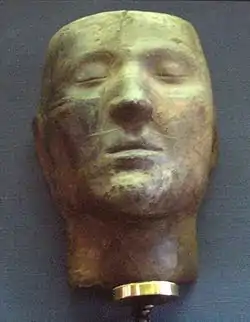Tashtyk culture
The Tashtyk culture was an archaeological culture that flourished in the Yenisei valley in Siberia from the first to the fourth century CE. Located in the Minusinsk Depression, environs of modern Krasnoyarsk, eastern part of Kemerovo Oblast, it was preceded by the Tagar culture.[1][2]


The Tashtyk culture was first surveyed by the Russian archaeologist Sergei Teploukhov.[3] Teploukhov suggested that it had been initially Indo-European dominated, only to become overcome by the Yenisei Kirghiz around the 3rd century AD.[3] The Yenisei Kirghiz are often associated with the Tashtyk culture.[4]
Tashtyk settlements and hill-forts have been unearthed throughout the Yenisei region, particularly the Sayan canyon area. Their most imposing monuments were immense barrows-crypt structures; these have yielded large quantities of clay and metal vessels and ornaments. In addition, numerous petrographic carvings have been found. Some of the graves contained leather models of human bodies with their heads wrapped in tissue and brightly painted. Inside the models there were small leather bags probably symbolising the stomach and containing burned human bones. Scaled-down replicas of swords, arrows and quivers were placed nearby. The animal motifs of the Tashtyk belonged to the Scytho-Altaic style, while they were also under significant Chinese influence.[1]
During his excavations of the Oglahty cemetery south of Minusinsk, Leonid Kyzlasov discovered a number of mummies with richly decorated plaster funerary masks showing Western Eurasian features, though this would not rule out some East Asian admixture, as revealed by ancient DNA (see below). There were also intact fur hats, silk clothes, and footwear (now in the Hermitage Museum, St. Petersburg).
In 2009, a genetic study of ancient Siberian cultures, the Andronovo culture, the Karasuk culture, the Tagar culture and the Tashtyk culture, was published in Human Genetics.[2] Six Tashtyk remains of 100–400 AD from Bogratsky region, Abakano-Pérévoz I, Khakassia were surveyed.[2] Extractions of mtDNA from three individuals was determined to belong to the Western Eurasian HV, H, and T1, while the others carried the North Asian haplogroup C and East Asian N9a.[2] Extractions of Y-DNA from the remains of one individual was determined to be of Y-chromosome haplogroup Western Eurasian R1a1, which is thought to mark the eastward migration of the early Indo-Europeans.[2] All individuals surveyed were determined to be Caucasoid, and were, except for one individual, light-eyed and light-haired.[2]
References
- Citations
- "Central Asian arts: Tashtyk Tribe". Encyclopædia Britannica Online. Encyclopædia Britannica. Retrieved February 15, 2015.
- Keyser, Christine; Bouakaze, Caroline; Crubézy, Eric; Nikolaev, Valery G.; Montagnon, Daniel; Reis, Tatiana; Ludes, Bertrand (May 16, 2009). "Ancient DNA provides new insights into the history of south Siberian Kurgan people". Human Genetics. 126 (3): 395–410. doi:10.1007/s00439-009-0683-0. PMID 19449030.
- Grousset 1970, pp. 18–19
- "Xipoliya Yanke Suo Jian Xiajiesi Monijiao" ("Siberian Rock Arts and Xiajiesi's Manicheism") 1998 Gansu Mingzu Yanjiu
- Sources
- Christian, David. A History of Russia, Central Asia and Mongolia. Blackwell Publishers, 1999.
- Grousset, René (January 1, 1970). The Empire of the Steppes: A History of Central Asia. Rutgers University Press. ISBN 978-0813513041. Retrieved February 14, 2015.
- Leonid Kyzlasov. Tashtyk Era (Таштыкская эпоха). Moscow, 1953. Page 13.
- "Oglakhty". Great Soviet Encyclopaedia, 3rd ed. 1969-1978.
- "Tashtyk culture". Great Soviet Encyclopaedia, 3rd ed. 1969-1978.
